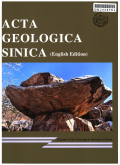- 钛学术文献服务平台 \
- 学术期刊 \
- 基础科学期刊 \
- 天文学、地球科学期刊 \
- 地质学报(英文版)期刊 \
Thermal Behavior and Determination of the Heated Structure of 11? Anomalous Tobermorite by in situ X-ray Diffraction
Thermal Behavior and Determination of the Heated Structure of 11? Anomalous Tobermorite by in situ X-ray Diffraction
基本信息来源于合作网站,原文需代理用户跳转至来源网站获取
摘要:
This article presents the thermal transitions of a tobermorite-bearing sample when heated from 30℃ up to 1200℃, both in vacuum and in static air, including tobermorite transforming to wollastonite, aragonite to calcite and calcite to lime. Characteristics obtained by in situ high temperature X-ray diffraction, field emission scanning electron microscopy and scanning transmission electron microscopy analyses jointly indicate that the investigated tobermorite is anomalous. The variations along the a, b, c axes and the volume changes of tobermorite with increasing temperature are described, and its thermal shrinkage coefficients therefore determined. The comparison between the refined structures at 30℃ and 800℃ demonstrates that the shrinkage degree (Δa/a0) along the a axis is higher than those (Δb/b0, Δc/c0) along the b and c axes. The wollastonite is formed in two ways: Tobermorite converting to wollastonite and lime reacting with quartz to form wollastonite.

推荐文章
低能量X-RAY测厚仪与β-RAY
测厚仪
薄膜
应用
比较
高分辨X-RAY成像系统的搭建及其血管造影研究
血管造影
后肢缺血模型
高分辨率X光机
基于X-Ray CT试验的塌陷区回填体孔隙结构研究
地表塌陷区
回填体
X-Ray CT
三维重构
孔隙结构
Geochemical assessment, mixing behavior and environmental impact of thermal waters in the Guelma geo
Geochemistry
Geothermometry
Mixing
Thermal effluents
Guelma
Algeria
内容分析
关键词云
关键词热度
相关文献总数
(/次)
(/年)
引文网络
引文网络
二级参考文献 (96)
共引文献 (0)
参考文献 (35)
节点文献
引证文献 (0)
同被引文献 (0)
二级引证文献 (0)
1954(1)
- 参考文献(1)
- 二级参考文献(0)
1956(2)
- 参考文献(2)
- 二级参考文献(0)
1957(2)
- 参考文献(2)
- 二级参考文献(0)
1962(1)
- 参考文献(1)
- 二级参考文献(0)
1978(1)
- 参考文献(1)
- 二级参考文献(0)
1983(1)
- 参考文献(0)
- 二级参考文献(1)
1986(1)
- 参考文献(0)
- 二级参考文献(1)
1987(1)
- 参考文献(0)
- 二级参考文献(1)
1989(1)
- 参考文献(1)
- 二级参考文献(0)
1992(1)
- 参考文献(0)
- 二级参考文献(1)
1994(4)
- 参考文献(0)
- 二级参考文献(4)
1996(4)
- 参考文献(1)
- 二级参考文献(3)
1997(4)
- 参考文献(1)
- 二级参考文献(3)
1998(2)
- 参考文献(0)
- 二级参考文献(2)
1999(6)
- 参考文献(4)
- 二级参考文献(2)
2000(5)
- 参考文献(3)
- 二级参考文献(2)
2001(2)
- 参考文献(1)
- 二级参考文献(1)
2002(3)
- 参考文献(0)
- 二级参考文献(3)
2005(5)
- 参考文献(0)
- 二级参考文献(5)
2006(1)
- 参考文献(0)
- 二级参考文献(1)
2007(4)
- 参考文献(0)
- 二级参考文献(4)
2008(3)
- 参考文献(1)
- 二级参考文献(2)
2009(6)
- 参考文献(2)
- 二级参考文献(4)
2010(6)
- 参考文献(0)
- 二级参考文献(6)
2011(11)
- 参考文献(1)
- 二级参考文献(10)
2012(6)
- 参考文献(0)
- 二级参考文献(6)
2013(4)
- 参考文献(3)
- 二级参考文献(1)
2014(6)
- 参考文献(1)
- 二级参考文献(5)
2015(6)
- 参考文献(1)
- 二级参考文献(5)
2016(7)
- 参考文献(2)
- 二级参考文献(5)
2017(12)
- 参考文献(1)
- 二级参考文献(11)
2018(7)
- 参考文献(2)
- 二级参考文献(5)
2019(5)
- 参考文献(3)
- 二级参考文献(2)
2021(0)
- 参考文献(0)
- 二级参考文献(0)
- 引证文献(0)
- 二级引证文献(0)
引文网络交叉学科
相关学者/机构
期刊影响力
地质学报(英文版)
主办单位:
中国地质学会
出版周期:
双月刊
ISSN:
1000-9515
CN:
11-2001/P
开本:
16开
出版地:
北京复外百万庄26号
邮发代号:
创刊时间:
1922
语种:
eng
出版文献量(篇)
3189
总下载数(次)
0
总被引数(次)
14369
期刊文献
相关文献
推荐文献
- 期刊分类
- 期刊(年)
- 期刊(期)
- 期刊推荐
力学
化学
地球物理学
地质学
基础科学综合
大学学报
天文学
天文学、地球科学
数学
气象学
海洋学
物理学
生物学
生物科学
自然地理学和测绘学
自然科学总论
自然科学理论与方法
资源科学
非线性科学与系统科学
地质学报(英文版)2022
地质学报(英文版)2021
地质学报(英文版)2020
地质学报(英文版)2019
地质学报(英文版)2018
地质学报(英文版)2017
地质学报(英文版)2016
地质学报(英文版)2015
地质学报(英文版)2014
地质学报(英文版)2013
地质学报(英文版)2012
地质学报(英文版)2011
地质学报(英文版)2010
地质学报(英文版)2009
地质学报(英文版)2008
地质学报(英文版)2007
地质学报(英文版)2006
地质学报(英文版)2005
地质学报(英文版)2004
地质学报(英文版)2003
地质学报(英文版)2002
地质学报(英文版)2001
地质学报(英文版)2000
地质学报(英文版)1999

 免费查重
免费查重










